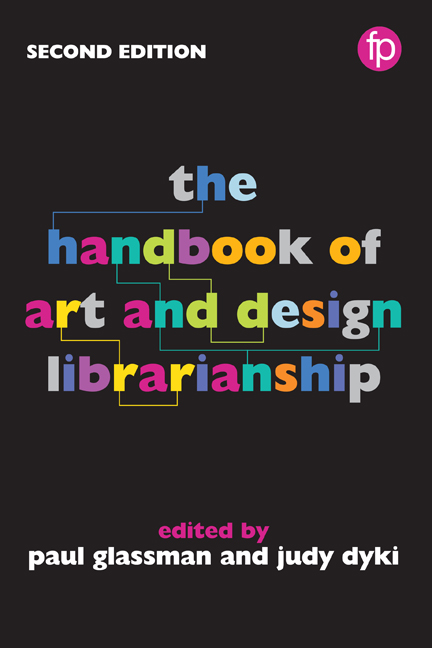Book contents
- Frontmatter
- Contents
- List of figures and tables
- Notes on contributors
- Foreword
- Preface
- Part I Roles and responsibilities
- Part II Materials and collection management
- Part III Teaching and learning
- Part IV Knowledge creation
- 21 The ever-shifting landscape: mapping the present and future of digital art histories
- 22 Critical cARTography: mapping spaces for dialogue about identity and artistic practices
- 23 More than just art on the walls: enhancing fine arts pedagogy in the academic library space
- 24 Beyond the monograph? Transformations in scholarly communication and their impact on art librarianship
- Part V The physical environment
- Part VI Promotion and sustainability
- Appendix Library profiles
- Index
21 - The ever-shifting landscape: mapping the present and future of digital art histories
from Part IV - Knowledge creation
Published online by Cambridge University Press: 08 June 2018
- Frontmatter
- Contents
- List of figures and tables
- Notes on contributors
- Foreword
- Preface
- Part I Roles and responsibilities
- Part II Materials and collection management
- Part III Teaching and learning
- Part IV Knowledge creation
- 21 The ever-shifting landscape: mapping the present and future of digital art histories
- 22 Critical cARTography: mapping spaces for dialogue about identity and artistic practices
- 23 More than just art on the walls: enhancing fine arts pedagogy in the academic library space
- 24 Beyond the monograph? Transformations in scholarly communication and their impact on art librarianship
- Part V The physical environment
- Part VI Promotion and sustainability
- Appendix Library profiles
- Index
Summary
Introduction
This chapter provides an overview of the practices, approaches and discourses that make up the diverse field of digital art history. The author first describes the general discourse around digital art history, exploring how art historians and arts information professionals have defined digital art history and positioned digital art history practices in relation to the broader field of art history. He then outlines specific tools and methods, offering examples of projects. Finally, he considers the role that art and design libraries, archives and museums can play in supporting scholars, students and the wider public in pursuing, creating and sharing digital art history projects.
Art and design librarians and other arts information professionals have a critical role to play in the future of digital art history. Identifying what this role might be is especially difficult, as digital art history is a moving target, developing in relation to dynamic technologies that promise an increasing range of possibilities. However, by mapping out the past and present of the field, information professionals will be better equipped to respond strategically to technological developments and work together towards a future of strong digital art historical scholarship.
The digital in art history
Digital technologies undeniably occupy a prominent position in nearly all aspects of current art historical research activities, teaching and knowledge production. Although relatively few in the field self-identify as ‘digital’ art historians, essentially all art history scholars depend on digital technologies to carry out their work, including such ubiquitous tools as PowerPoint and online library catalogues. The digital image repository, though, is perhaps the most significant digital resource to date for art history scholarship. Drucker (2013) refers to this phase of building up repositories of digital resources as digitized art history, work that has included scanning analogue images and crafting metadata descriptions. This work has also laid the foundation for what Drucker distinguishes as digital art history: the application of digital methods and computational analysis to the study of artworks and other art history research materials. With this still-growing infrastructure of digital resources, art historians can use computational tools to investigate objects of art historical research to new ends.
- Type
- Chapter
- Information
- The Handbook of Art and Design Librarianship , pp. 213 - 224Publisher: FacetPrint publication year: 2017



